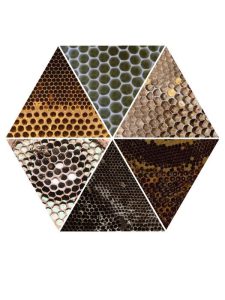Bees and wasps independently invent the same architectural tricks
Insects use the same types of non-hexagonal cells to overcome building challenges
AUBURN UNIVERSITY COLLEGE OF SCIENCES AND MATHEMATICS

IMAGE: PHOTO CREDIT: MICHAEL L. SMITH
At first glance, the hexagonal cells build by honey bees and social wasps may seem similar, but they are significantly different. Honey bees build using wax, whereas wasps use paper. Honey bees build their double-sided combs vertically, whereas wasps build single-sided comb horizontally (i.e., the opening of each cell faces downward).
Indeed, the hexagonal cells built by these two groups have independent evolutionary origins. Just like sharks and whales have similar body plans due to their watery environment, bees and wasps build hexagonal cells because the shape maximizes strength and storage area, while minimizing building materials.
But what happens when perfectly hexagonal cells cannot be built? Do bees and wasps fix their building problems in the same way?
In a subset of honey bee and wasp species, workers build two different sizes of hexagons. The smaller cells are used for rearing workers, and the larger cells are used for rearing reproductives; drones and queens. This difference in cell sizes creates an inherent architectural problem: how do you tile two differently-sized hexagons within a single sheet of comb?
To determine how different species solved the same architectural problem, the researchers needed nest images that included both worker and reproductive cells in the same comb.
First-author Dr. Michael L. Smith, Assistant Professor in the Department of Biological Sciences at Auburn University, and Affiliate Member of the Max Planck Institute for Animal Behavior, contacted researchers across the globe for potential images. They then used custom-built software to extract per-cell metrics from 22,745 individual cells.
In some species, like Metapolybia mesoamerica, worker and reproductive cells are the same size, so there was no architectural hurdle to overcome. In other species, like Apis andreniformis, reproductive cells are up to 2.7 times larger than worker cells, which creates a serious building problem – how to combine these wildly different hexagons in an efficient way?
Looking across 10 species, the researchers found that as the scale of the building problem increased (the size difference between worker and reproductive cells), workers began incorporating non-hexagonal cells. These irregular cells were mostly 5- and 7-sided, but they were consistently built in pairs, with the 5-sided cell built on the worker-side, followed by a 7-sided cell on the reproductive side. This pattern was seen in all the honey bee and wasp species that had a cell-size difference to overcome. For a group of insects renowned for their hexagonal cells, this alone was interesting, as it showed that they all rely on the same non-hexagonal configurations.
The researchers then built a mathematical model that would predict, based on the cell-size difference, how many non-hexagonal cells should be incorporated into the worker-to-reproductive transition. Surprisingly, some of the species were consistently performing better than expected. Upon closer investigation, the researchers saw that these species also incorporated intermediate-sized cells into the transition region. The intermediate-sized cells were still hexagonal, but they allowed the insects to “split the difference” and turn the cell-size transition into a series of smaller ones, which didn’t require non-hexagonal cells.
These same building tricks were adopted across all species of bees and wasps investigated. Despite being separated by over 179 million years of evolution, using different building materials, and independent origins of hexagonal cells, these species have all arrived at the exact same solution to this scalable architectural problem.
“Once we were able to plot out all the data, the results were striking – you could see how the bees and wasps used intermediate-sized cells to make a gradual change, but also how consistently the non-hexagonal cells were arranged in the comb” said Michael L. Smith.
This work has implications for how collective systems can build adaptive and resilient structures without centralized control. There is no single bee or wasp “architect” building the entire structure, instead, it is hundreds or even thousands of individuals contributing to the final product.
This work, titled “Honey bees and social wasps reach convergent architectural solutions to nest-building problems,” was published 27 July 2023 in the journal PLOS Biology.
This study was funded by the National Science Foundation, the German Research Foundation, a Packard Fellowship for Science and Engineering, and GETTYLABS.
This manuscript is published in PLOS Biology and is freely available at the following link: http://journals.plos.org/plosbiology/article?id=10.1371/journal.pbio.3002211
We are here to share current happenings in the bee industry. Bee Culture gathers and shares articles published by outside sources. For more information about this specific article, please visit the original publish source: http://journals.plos.org/plosbiology/article?id=10.1371/journal.pbio.3002211






